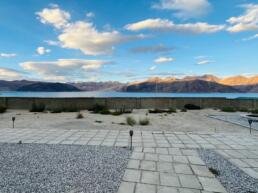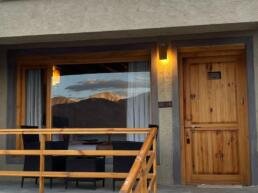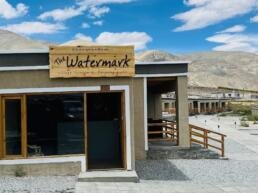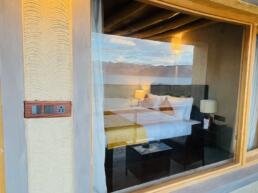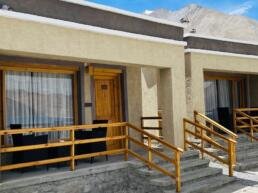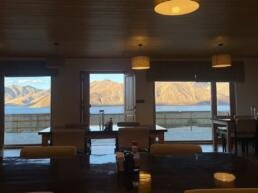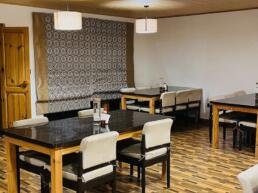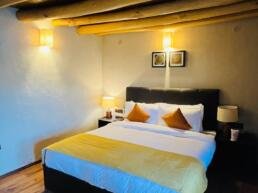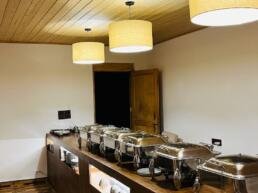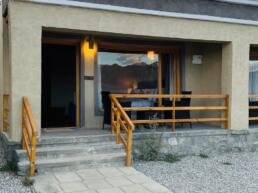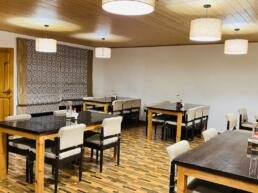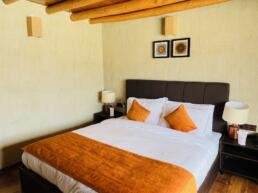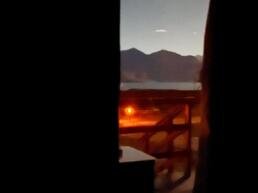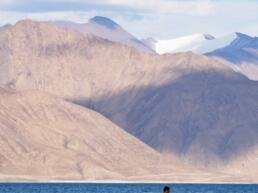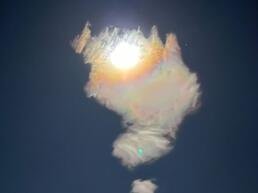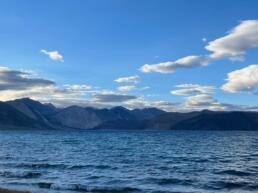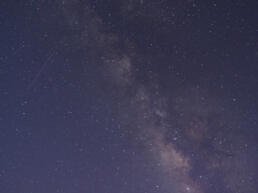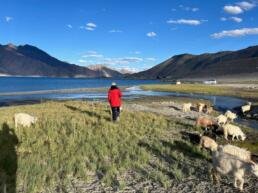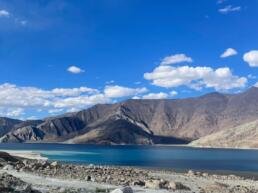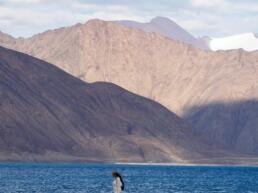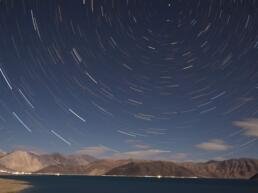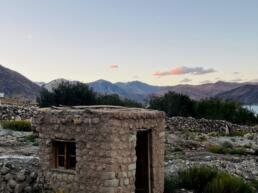The first light in Nubra fell softly on our third morning, as if the valley itself was waking up slowly. We made our move from it just as the seabuckthorn orchards began to glow gold under the morning sun, Diskit’s ancient monastery clung to the cliffs — a quiet sentinel, watching us leave.
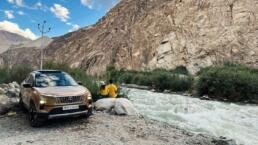
The journey itself was a study in contrasts. Leaving the ochre-toned vastness of Leh, we ascended towards the formidable Khardung La—one of the highest motorable passes in the world, a mountain of myths and memories. At 18,380 feet, the air was thin, but the energy of the place was thick with history and the hum of engines struggling against the altitude.
The drive towards Pangong, we found, is less a road trip and more a meditation. The mountains here seem older, gentler than the sharp spikes of Leh. Their faces are worn smooth by time. Crossing Agham and winding along the Shyok River, we saw Ladakh’s contradictions in full bloom — dry riverbeds giving way to sudden thickets of wild rose, barren cliffs merging with muscular but shy Kiangs, hiding tiny grazing goats with their bells echoing through empty valleys.
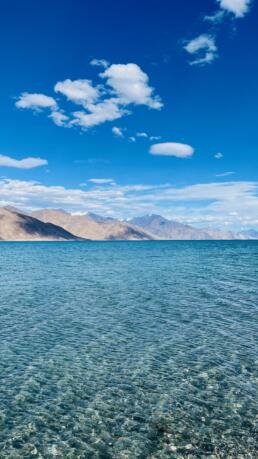
By afternoon, the road began to rise and the colors shifted: rust-reds and ochres giving way to the bruised purples and icy whites of high altitude. And then — like a secret finally revealed — Pangong appeared.
Locals call the Shyok the “River of Death,” not from fear, but from respect. In summer, it can swell without warning, swallowing paths and vehicles alike. But today, it was docile — a ribbon of silver whispering alongside us, sometimes so close we could taste its cool spray through open windows.
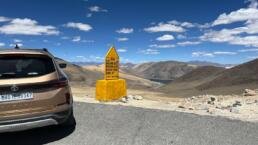
Along the way, villages like Durbuk and Tangtse appeared like gentle interruptions, a few whitewashed homes huddled against the whim of the winds. Prayer flags stretched like faded whispers across chortens, and the road itself sometimes seemed no more permanent than a scratch across a stone. By afternoon, the road began to rise and the colors shifted: rust-reds and ochres giving way to the bruised purples and icy whites of high altitude. And then — like a secret finally revealed — Pangong appeared.
One minute, the world is brown and grey and stubborn; the next, it’s liquid cobalt under an endless sky without any fanfare.
No photograph prepares you for it.
The lake lay still and wide, a blue so deep it could have been a dream. Near to its shores, tucked modestly into the landscape, was our home for the next 3 nights — Pangong WaterMark Resort.
The WaterMark breathes with the land. Sturdy cozy cottages blend into the muted colors around them, and from every window, the lake stretches out like a painted scroll. Through the day, we watched the lake change color from the bluest of blues, to steel to lavender to inky black.
“
One minute, the world is brown and grey and stubborn; the next, it’s liquid cobalt under an endless sky without any fanfare.
“
Warm, wholesome meals and hearty cups of butter tea, it felt less like a hotel stay and more like visiting an old friend’s home — where conversations stretched lazily, and no one was in a hurry to end the evening. In any case, Ladakh doesn’t measure time by clocks but by the shifting light on stone and water. In Nubra, we had woken to the green breath of the valley; here at Pangong, we slept under an endless ceiling of stars, the cold biting but clean.
When we first traveled to see the high altitude lake in 2016, Pangong was a wilderness of makeshift tents and a few sputtering generators. No paved paths, no framed windows — just nylon flapping in the cold wind, and tourists huddled around smoky fires. Back then, a night at Pangong felt like an adventure wrested from the elements.
Today, though development has inched in cautiously, the soul of Pangong remains mercifully unchanged.
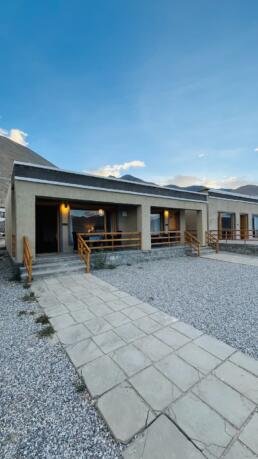
In the evening, sitting by the fire pit, the staff at WaterMark — mostly young locals from northern India — told us stories: of frozen winters when Pangong becomes a road of ice, of yaks wandering down to the water’s edge, of nights so cold the stars crackle, of the Chinese and the treasures we lost.
There’s a tension beneath Pangong’s beauty, invisible but ever-present. Two-thirds of this vast lake lies beyond our reach, across the Line of Actual Control, in territory administered by China.
Pangong has been a silent witness to decades of Indo-China friction, most notably the clashes of 1962 and more recent skirmishes in 2020. Military posts dot the region discreetly; every local has a story of sudden evacuations, of soldiers moving through under cover of night.
Mobile reception here is patchy at best, a reminder that sometimes, disconnection is protection. In these moments, the lake feels less like a tourist site and more like a living boundary.
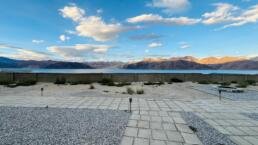
Next morning,we drove out to the newly opened Rezang La War Memorial and Museum, near Chushul. The kind staff at the WaterMark packed us aaloo parathas (spiced potato stuffed breads) and mirchi ka achaar (chilli pickles) for our journey – by far the most favorite meal I had on my trip in Ladakh. The drive itself was a study in Ladakh’s contrasts — smooth black tarmac cutting through seas of stone and sand.
Rezang La is a name stitched into Indian military legend. Here, in 1962, 120 soldiers of the 13 Kumaon Regiment held their post against overwhelming Chinese forces. Only one survived. The museum, stark and respectful, doesn’t glorify battle — it simply tells the story as it was, with black-and-white photographs, handwritten letters, and artifacts found scattered across the frozen battleground.
Back at WaterMark that evening, the fire crackled more loudly. One of the young attendants told us how his grandfather had been a porter for Indian troops during the 1962 war, carrying supplies across frozen passes with little more than yak wool boots for protection. “They were not soldiers,” he said, “but they fought with their hearts.”
We set up our telescopes and sat by the pit long after dinner, watching the moon and the milky way emerge in violent clarity, lighting up the land and lake.. It was hard not to feel small — but also strangely weightless, like a pebble tossed in the timeless currents of this place.
Next morning, as we packed to leave, I realized: Ladakh does not reveal itself quickly. It demands patience. It asks you to listen. To watch. To let go of your need to conquer landscapes the way you do cities.
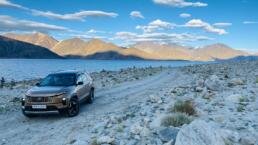
It rewards those who stay a little longer, ask fewer questions, and simply… be.
At WaterMark, by the side of a lake that had seen more seasons than any of us could dream of, it was easy to remember that sometimes, stillness is the greatest journey of all.
We said our goodbyes softly — not to mark an end, because in Ladakh, nothing really ends. It only waits, quietly, for you to return.
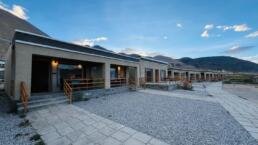
IF YOU GO
- Stay: Pangong WaterMark Resort (2 nights) offers mud cottages with uninterrupted views of the lake.
- Getting There: From Nubra Valley, the drive via Shyok village takes about 6-7 hours. Roads are rough; if self-driving, then 4×4 recommended.
- Don’t Miss: Rezang La War Memorial and the surrounding villages of Spangmik and Chushul.
Connectivity: BSNL offers limited coverage; expect to be mostly offline — and all the better for it.

